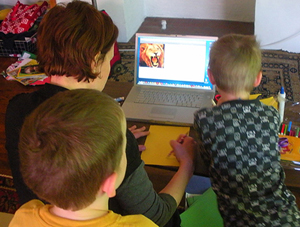| Sun | Mon | Tue | Wed | Thu | Fri | Sat |
|---|---|---|---|---|---|---|
| 1 | 2 | 3 | 4 | 5 | ||
| 6 | 7 | 8 | 9 | 10 | 11 | 12 |
| 13 | 14 | 15 | 16 | 17 | 18 | 19 |
| 20 | 21 | 22 | 23 | 24 | 25 | 26 |
| 27 | 28 | 29 | 30 | 31 |
CATEGORIES
RECENT ENTRIES
BLOG ROLL
Watt experiment
My kids need a project for the science festival. They are in the first grade at a Hyde Park public school, and this year, unlike free-wheeling kindergarten, science-fair projects are mandatory. Acceptable projects, the school note explains, include experiments, research reports, and collections with “scientific value.” (Caveat: “Your Hot Wheels collection or some other toy collection is not scientific.”)
Considering that most first-graders can barely read, you could call this assignment academically rigorous, or (depending on your educational philosophy) absolutely ridiculous. But I don’t want my kids to be the only ones without a science-festival project, so I set about doing it for them. I mean, um, helping them do it.
Kid B decides he wants to do a report on the platypus. His babysitter, who likes to make crafts, helps him fashion a platypus out of clay.
Kid A isn’t sure what to do. Then one day at work late April, I come across a news announcement on the Regenstein Library Web site:
“ComEd has recently offered Kill A Watt™ meters to libraries for checkout. These meters measure the electricity used to run electrical devices. Kill A Watt™ Power Meters have been placed on reserve and are available for checkout for seven days at both Crerar and Regenstein Circulation.”
 Aha! I propose the idea of an experiment to Kid A: What uses the most electricity?
Aha! I propose the idea of an experiment to Kid A: What uses the most electricity?
He is underwhelmed. I try another approach: Did you know that appliances that use electricity—even when they are turned off—are called “electricity vampires?”
“Vampires?” he says. “Are they really called that?” We have a science project.
On Saturday I have to be on campus, so I stop off at Regenstein. It’s not long after Earth Day, but apparently there has not been a run on Kill A Watt™ meters. One of the circulation assistants has heard of the program, but isn’t sure where the meters are filed. Someone else helpfully phones Crerar. I walk over there and walk out with a meter.
The week passes. With Little League and swimming lessons and a houseguest, we don’t get to the science experiment. On Monday morning, I receive an e-mail warning that the meter is overdue. When I call, hoping to renew over the phone, I’m told the fine for reserve materials is a dollar an hour.
I rush home from work and pick up Kid A. He suggests we start with the halogen lamp—a smart suggestion. (Once, the lamp was accidentally left on for a week or so, and the electricity bill was $20 higher than usual.)
I read the instructions while Kid A peels off the protective sticker; we are the first ones to use the meter. We plug it in and start pressing buttons: volts, amperes, hertz, kilowatts. The brochure does not explain how long the measuring process takes.
It’s one of the first warm afternoons of spring. It occurs to me that the dollar-per-hour cost is negligible compared to the opportunity cost of being stuck inside. Most of our neighbors are already in the backyard, drinking beer or playing in the sandbox, depending on age. Kid A and I look at each other. We would much rather be conducting experiments in applied physics, i.e. throwing a ball around in the light well.
After eight minutes, the lamp has used two watts of electricity (whether that is a lot or not, I couldn't say), and Kid A has completely lost interest in his experiment. “Can I do a report instead?” he asks. “Can I do a report on lions?”
He goes over to the babysitter’s to start on his clay lion while I take the meter back to Crerar. I pay the fine of six dollars—turns out it’s not charged by the hour, but a flat rate of three dollars a day.
The circulation assistant is intrigued. “Was it useful?” he wants to know.
“Kind of,” I say.
Now I just need to get a book on lions.
Carrie Golus, AB'91, AM'93
May 12, 2010
